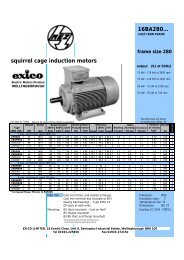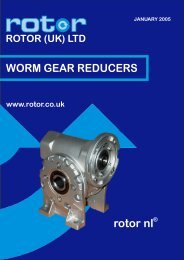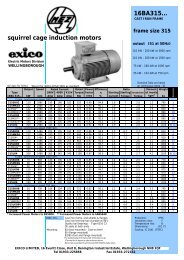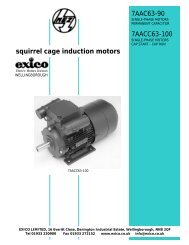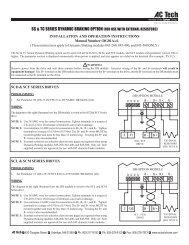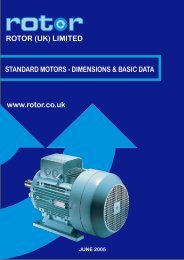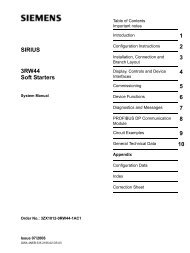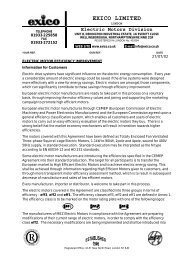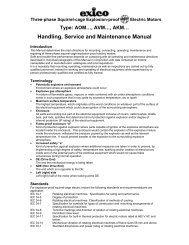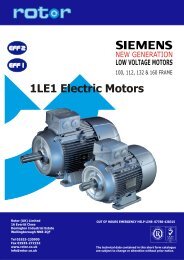Worm Gear Reducers (MRT) - Rotor UK
Worm Gear Reducers (MRT) - Rotor UK
Worm Gear Reducers (MRT) - Rotor UK
Create successful ePaper yourself
Turn your PDF publications into a flip-book with our unique Google optimized e-Paper software.
4. GEAR UNIT SELECTION<br />
General<br />
The wide range of ratios specified in the catalogue enables to solve any requirements resulting from the operation of various<br />
equipment. The following data are necessary to specify a suitable gear unit:<br />
a) input and output speed determining the gear ratio i<br />
b) required torque M k<br />
or input power P 1<br />
The data given in the tables 7.1 to 7.4 enable easy selection of a suitable gear unit. Should a non-standard unit be required please<br />
contact your distributors for the technical support.<br />
<strong>Gear</strong> Ratio i<br />
<strong>Gear</strong> ratio is a relation between input speed n 1<br />
[rpm] and output speed n 2<br />
[rpm].<br />
n<br />
i = 1<br />
[-]<br />
n 2<br />
<strong>Gear</strong> ratios from 5 to 100 are used at worm-gear units. The use of squirrel cage asynchronous motors is recommended to drive<br />
the equipment as their speed n 1<br />
[rpm] is almost constant even if under load. The following speed can be used for 50 Hz:<br />
2-pole motor n 1<br />
= 2800 rpm<br />
4-pole motor n 1<br />
= 1400 rpm<br />
6-pole motor n 1<br />
= 900 rpm<br />
8-pole motor n 1<br />
= 700 rpm<br />
Two-pole motors are usually suitable for short-time operation. Their use should be consulted with the manufacturers. When<br />
60 Hz supply frequency is used the increase of the input as well as output speed by 20 % need to be taken into consideration.<br />
Torque M 2<br />
The required torque M k<br />
is determined by the load applied on the gear unit. It can be described as force F applied at certain<br />
distance of the arm r.<br />
M k<br />
[Nm] = F [N] × r [m]<br />
The output torque M 2<br />
can be calculated from the following formula:<br />
M 2<br />
[Nm] = 9550 × P [kW] × η [%] × i<br />
1<br />
100 × n 1<br />
[rpm]<br />
The output torque M 2<br />
need to be selected at a higher value than the required torque. Output torque related to individual gear<br />
ratios is specified in the <strong>Gear</strong> Unit Selection Table 7.4.<br />
Input and Output Power P 1<br />
and P 2<br />
Motor input power can be calculated from the general relation between torque M and speed n:<br />
P [kW] =<br />
M [Nm] × n [rpm]<br />
9550<br />
The efficiency η of a gear unit is given by the ratio of the output power P 2<br />
and the input power P 1<br />
, see Table 7.1 to 7.3.<br />
P 1<br />
[kW] =<br />
M k<br />
required [Nm] × n 2<br />
[rpm]<br />
9550 × η [%]<br />
5. SERVICE FACTOR<br />
Operation factor S m<br />
In order to guarantee operation safety at various loads and operation conditions the type of the gearbox (and motor) must be<br />
specified through the operation factor S m<br />
. The values of operation factor S m<br />
can be found in Table 5.1 taking the type of load,<br />
the average daily operation, the number of starts per hour into consideration. These values are applicable when the gear unit<br />
is used in conjunction with an electric motor. Should a brake motor be used the operation factor S m<br />
needs to be multiplied by<br />
a coefficient of 1.15.<br />
When selecting an actual gear unit the operation factor S m<br />
must be lower than the gear unit service factor S f<br />
or the required output<br />
torque M p<br />
must be increased as per the following formula:<br />
M 2<br />
= M p<br />
× S m<br />
prior to alterations<br />
6




